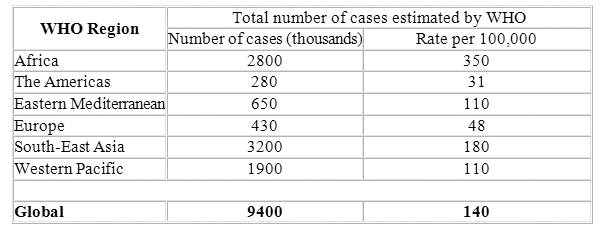
FINAL DIAGNOSIS
CAVITARY PULMONARY TUBERCULOSIS WITH TUBERCULOUS MENINGITIS
DISCUSSION
The World Health Organization (WHO) estimates there were 9.4 million incident cases of tuberculosis in the world in 2008 (range 8.9-9.9), a rate of 140 cases per 100,000 population (range 130-150) (see Table 2). [1] In the US, there were 15,000 estimated number of cases, a rate of 4.8 cases per 100,000 population. It is also estimated that there were 1.3 million tuberculosis deaths in HIV-negative people (range 1.1-1.7) and an additional 0.52 million tuberculosis deaths occurred in HIV-positive people (range 0.45-0.62).
Table 2. WHO estimates of tuberculosis incidence by WHO region, 2008 [1]

This case illustrates the difficulty in using laboratory methods to diagnose tuberculous meningitis. The diagnosis of tuberculous meningitis remains largely clinical due to low sensitivities of both CSF AFB smear and culture, the "gold standard" tests of diagnosis. Routine AFB smear on CSF has a reported yield of 20%-55% while the sensitivity of CSF AFB culture is around 60%. [2] Multiple factors contribute to such low yields. The first is the paucibacillary nature of tuberculous meningitis, likely due to the ependymal location of the infection. A case of tuberculous meningitis may have fewer than 1 bacillus per milliliter of CSF, therefore a large volume of CSF must be processed in an effort to capture this elusive organism. Second, the buoyant tendency of Mycobacteria, due to their lipid-rich cell wall, can create sampling difficulty.
Molecular diagnostics holds promising advances in the identification and diagnosis of M. tuberculosis in the CSF, however the current assays are still plagued with low sensitivities. In a meta-analysis of all nucleic acid amplification tests available, the average sensitivity was 71% with a range of 25% to 100%. The specificities averaged 95% with a range of 62% to 100%. [3] The negative likelihood ratios are not low enough though to exclude tuberculous meningitis when a negative result is obtained from the nucleic acid amplification test. Suggestions on improving the yield of such assays include filtration, increasing sample volume, and pretreatment with the detergent sodium dodecyl sulfate (SDS). [2,4] However, there is no method that seems to reliably increase the sensitivity to an acceptable percentage. Current hypotheses for such low sensitivities in the nucleic acid amplification methods include the presence of inhibitors of amplification in the CSF, rarity of the AFB in the small volume of CSF specimen collected, and differences or degradation of the primer sites utilized by the assays.
Treatment
The patient was started on standard M. tuberculosis therapy including Isoniazid, Rifampin, Ethambutol, and Pyrazinamide as well as Pyridoxine due to his history of alcohol use. He was also started on an IV dexamethasone taper and after three weeks, switched to oral prednisone taper as suggested by Thwaites et al. [5,6] The same authors emphasize the well-known point that treatment of suspected tuberculous meningitis should not be delayed while waiting for microbiological or molecular diagnostic confirmation.
The patient's mental status improved to baseline and he was discharged home with daily visits from the county health department. He was to remain under home quarantine until three consecutive sputum smears were negative for AFB.
REFERENCES
![]() Contributed by Sarah Harm, MD and A. William Pasculle, ScD.
Contributed by Sarah Harm, MD and A. William Pasculle, ScD.